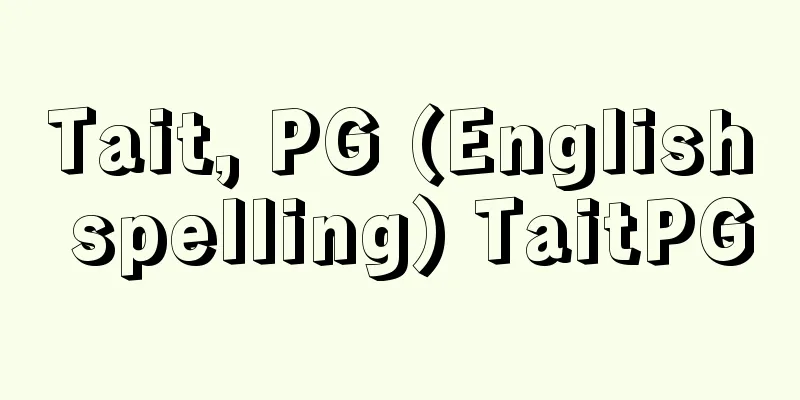Vanuatu - Republic of Vanuatu (English spelling)

|
A Melanesian archipelago nation located southeast of the Solomon Islands and west of Fiji. Its official name is the Republic of Vanuatu. Its land area of 12,189 square kilometers is equivalent to the size of Niigata Prefecture. Its population is 234,023 (2009 census), 265,000 (2013 UN estimate), and it gained independence from the British-French Joint Dominion in July 1980. Its three official languages are English, French, and a form of pidgin English called Bislama. The capital is Vila (Port Vila) on the island of Efate, with 44,040 people (2009), more than 10% of the total population. [Izumi Kobayashi] Nature and GeographyThe 83 islands that stretch over a distance of 800 km were formerly known as the New Hebrides. The largest island is Espiritu Santo (3,678 square km), which contains the country's highest peak, Mount Tabwemasana (1,880 m). Efate, where the capital, Vila, is located, is located almost in the center of the archipelago. About half of the islands are volcanic, with steep mountains surrounded by small areas of plain. The volcanoes on Ambrym, Tanna, and Urbea are still active. These islands are part of the Pacific Ring of Fire, and earthquakes of magnitude 7 or more often occur in the seas off the coast. Most of the other small islands are coral reefs. The uninhabited islands of Matthew and Hunter, at the southernmost tip, are the subject of a territorial dispute with the French overseas territory of New Caledonia. The climate in the south is tropical and marine, but the southern islands are closer to subtropical, and due to the influence of the southeast trade winds, temperatures can drop to around 20°C from May to October. The average annual precipitation is 2,300 mm, but the amount increases from south to north. 98% of the population is Melanesian, with some French, Vietnamese and Chinese. The region is divided by rugged terrain and has scattered islands, which is a typical Melanesian feature, and the size of village communities is relatively small. As a result, there are more than 100 independent languages in the country, and pidgin English has developed as a regional common language. In Vanuatu, this is called Bislama and is the national language. Apart from the inhabitants of the two largest cities, the capital and Santo (Lugamville; population 13,167 as of 2009) on Espiritu Santo Island, most people live in rural or forested areas and live as a traditional agricultural society. They mainly cultivate rootstocks such as taro and yams, and pigs with tusks are valued not only for their meat but also as currency. They have the skill to grow tusks in a round shape, and the longer the curled tusks, the more valuable they are. These curled pig tusks are a traditional symbol of Vanuatu, and a stylized design is featured on the national flag. [Izumi Kobayashi] historyThe first recorded Westerner to set foot on the islands was the Portuguese Pedro Fernández de Quirós (1565-1615), who landed on the island of Espiritu Santo on April 27, 1606. The area was named the New Hebrides by the British navigator James Cook, who visited the area in 1774. After that, a territorial dispute between Britain and France continued, and in 1906, the two countries agreed to a rare form of joint governance, the condominium. This method of governance did not separate the British and French areas, but rather involved a complex dual governance, for example, the French would build a French-language elementary school next to an English-language elementary school built by the British. This caused a gap in thinking and communication between French- and English-language residents. In the 1970s, the momentum for independence grew among some residents, and while the UK accepted it, the French government rejected it. Independence movements broke out on the islands of Tana and Espiritu Santo, where many French residents lived, with individual islands often declaring their independence. In the midst of this, the UK persuaded the French government to recognize the independence of the Republic of Vanuatu on July 30, 1980, but at this time the French and French-speaking residents of Espiritu Santo took up arms in opposition to independence, sparking the "Santo Rebellion." [Izumi Kobayashi] PoliticsThe political system is a republic with a president (five-year term) as head of state. The president is elected by an electoral college consisting of members of the National Assembly and the speakers of each state assembly. The president appoints the Chief Justice of the Supreme Court and three other judges, but executive power is vested in the Cabinet, making it a parliamentary system. The parliament is unicameral with 52 seats, and members serve four-year terms. At the time of independence there were 11 states, but since 1994 they have been consolidated into six states. The British-French joint rule created two groups of residents based on whether they were educated in the British or French language. This, combined with traditional tribal interests, has led to the emergence of multiple political parties, creating a complex and unstable political situation. Although parliament members serve four-year terms, this is also the reason why 11 people and 21 prime ministers have emerged in the 36 years since independence (as of February 2016). In terms of diplomatic relations, it is of course a member of the Pacific Islands Forum (PIF), and is deepening ties with fellow Melanesian nations Papua New Guinea and Solomon Islands, and the Melanesian Spearhead Group (MSG) headquarters is located in the capital, Bira. After gaining independence as a republic, it remains a member of the Commonwealth of Nations. [Izumi Kobayashi] Economy and SocietyWhile 70% of the population is engaged in self-sufficiency agriculture and coastal fishing in a non-monetary economy, the remaining 30% generate domestic production through small-scale industrial agriculture and tourism. The livestock farming business run by French people has been continued, and beef is the main export product. The varied topography, including active volcanoes, and the exotic appearance of the capital city, Villa, built by French people, create an atmosphere not often seen in the surrounding island nations that gained independence from the British Commonwealth. The prototype of bungee jumping, which was invented by New Zealanders, was a coming-of-age ceremony in which participants jumped from the top of a tower found on Pentecost Island. The island's appeal, such as these, attracts more than 170,000 tourists a year. The national currency is the X. The GDP (gross domestic product), which indicates the scale of economic production, is $815 million per year (2014, World Bank). The GNI (gross national income) per capita is $3,160 (2014, World Bank), but considering the prevalence of the monetary economy, it is estimated that the real income level of urban residents is more than double this. This means that even within the same country, the lifestyles of people in urban areas and those in rural and mountainous areas are very different. In a world happiness ranking published by a British think tank in 2006, Sweden was ranked first out of 178 countries and drew attention as the "happiest country in the world." Christianity is widespread as a religion, and most of the population is said to be Christian, but indigenous beliefs remain deeply rooted in traditional society. The education system consists of eight years of primary education and four years of secondary education, with an enrolment rate for primary education of 96%. The literacy rate for the entire population is below 64%, but approaches 80% for those under 35. There are two types of schools, primary and secondary, where either English or French is used, and citizens are free to choose which to attend. There is a branch of the University of the South Pacific (main campus in Fiji) within the country, but those seeking higher education go on to study at the University of the South Pacific or at a university in Australia or New Zealand. Some people who have received a French education go to study at a university in the neighbouring French territory of New Caledonia, but the number of English speakers is gradually increasing. [Izumi Kobayashi] Relations with JapanDuring the Pacific War, the Allied forces confronted the Japanese forces that invaded the Solomon Islands from Vanuatu, so the areas east and south of this region were not affected by the fighting. The surrounding waters are not as good fishing grounds as the Solomon Islands, and there are no fisheries agreements between the two countries. Diplomatic relations with Japan were established in 1981. An honorary consulate was opened in Tokyo, but closed in 2003. Japan is also accredited by the ambassador to Fiji. In addition to dispatching Japan Overseas Cooperation Volunteers, the cumulative amount of ODA (Official Development Assistance) provided by Japan as of fiscal year 2013 was 25.107 billion yen. [Izumi Kobayashi] [References] | | | | Island| | | | | | | [Supplementary information] |"> Vanuatu flag ©Shogakukan Illustration/Shogakukan Creative "> Vanuatu Location Map Source: Shogakukan Encyclopedia Nipponica About Encyclopedia Nipponica Information | Legend |
|
ソロモン諸島の南東、フィジーの西側に位置するメラネシアの群島国家。正称バヌアツ共和国Republic of Vanuatu。国土面積1万2189平方キロメートルは新潟県の広さに相当する。人口は23万4023(2009国勢調査)、26万5000(2013国連推計)で、1980年7月にイギリス・フランス共同統治領から独立した。英語、フランス語のほかにビスラマ語とよばれるピジン英語の三つが公用語。首都はエファテ島のビラ(ポート・ビラ)で、全人口の1割超の4万4040人(2009)が住んでいる。 [小林 泉] 自然・地誌800キロメートルの範囲に連なる83の島々は、かつてニュー・ヘブリデス諸島とよばれた。最大の島はエスピリツ・サント(エスピリッツ・サント)島(3678平方キロメートル)で、ここには国内最高峰のタブウェマサナ山(1880メートル)がある。首都ビラのあるエファテ島は、列島のほぼ中央に位置する。島々の約半分は火山島で、険しい山の周りに平地がわずかにあるという地形で、とくにアンブリム島、ターナ島(タンナ島)、ウルベア島の火山はいまも活動している。これらは環太平洋火山帯の一部をなしているため、近海ではしばしばマグニチュード7超級の地震が起きている。そのほかの小さな島々は、大方がサンゴ礁島。最南端にある無人島マシュー島とハンター島は、フランスの海外領土ニュー・カレドニアとの間で領有問題を抱えている。熱帯海洋性気候に属するが、南部の島々では亜熱帯性に近く、南東貿易風の影響下にもあって5月から10月にかけては気温が20℃前後に低下することもある。降水量は年平均で2300ミリメートルであるが、南から北に行くほど降雨量が増える。 住民はメラネシア系が98%を占め、若干のフランス系やベトナム系、中国系がいる。険しい地形に分断されて島々が散在しているメラネシア的特徴がこの地域にもみられ、村落集団の規模は比較的小さい。そのため国内には100以上もの独立言語が存在するので、地域共通語としてピジン英語が発達。バヌアツでは、これをビスラマ語とよび国語とした。 首都ならびにエスピリツ・サント島のサント(ルガンビル。人口1万3167、2009年)の2大都市住民以外は、農村部もしくは森林部に住み、昔ながらの伝統農耕社会に暮らしている。タロ、ヤムなどの根茎類栽培を主とし、牙(きば)のあるブタは食肉的価値とともに貨幣的役割も果たす。牙を丸めて育てる技術があり、渦を巻いた牙が長いほど高価値を有する。この渦を巻いたブタの牙はバヌアツの伝統的シンボルで、図案化されて国旗のデザインにもなっている。 [小林 泉] 歴史記録ではこの諸島に最初に足を踏み入れた西洋人は、ポルトガル人のペドロ・フェルナンデス・デ・キロスPedro Fernández de Quirós(1565―1615)で、1606年4月27日にエスピリツ・サント島に上陸している。この地域をニュー・へブリデス諸島と命名したのは、1774年にこの地を訪れたイギリス人航海者ジェームズ・クックである。その後、イギリス、フランスの領有権争いが続き、1906年に両国が共同統治condominium(英仏共同統治)するという世界でも珍しい形態での合意が成立。この統治方法は、イギリス統治区とフランス統治区を分けたのではなく、たとえばイギリスが英語教育の小学校を建設した隣に、フランスがフランス語教育の小学校を建てるというように、二重統治ともいえる複雑な実態であった。これがフランス語教育系と英語教育系の住民間に思考ギャップやコミュニケーションギャップを引き起こした。 1970年代になると、一部住民の間に独立機運が高まり、イギリスが受け入れる一方、フランス政府は独立を拒んだ。フランス系住民が多く住んでいたターナ島やエスピリツ・サント島では、しばしば1島による独立宣言をするなどの独立運動も起こった。こうしたなか、イギリスはフランス政府を説得して、1980年7月30日にバヌアツ共和国としての独立を認めたが、このとき、エスピリツ・サント島のフランス系ならびにフランス語系住民が、武器を取って独立に反対する「サントの反乱」が起きた。 [小林 泉] 政治政体は大統領(任期5年)を国家元首とする共和制。国会議員と各州議会議長から成る選挙人団が大統領を選出する。大統領は最高裁判所長官とほかの3人の裁判官を指名するが、行政権は内閣にある議院内閣制。議会は議席数52の一院制で、議員の任期は4年。独立時の地方行政は11州であったが、1994年からは6州に統合された。 英仏共同統治という形態は、イギリス、フランスのどちらの言語で教育を受けたかによる二つの住民グループをつくり出した。これに伝統的な部族間の利害が絡まって複数政党が林立し、複雑で不安定な政治状況を生み出している。議員任期は4年あるものの、独立以来36年(2016年2月時点)で11人21代の首相が出現している事情もそこにある。 外交関係では、太平洋諸島フォーラム(PIF)への加盟はもちろんであるが、同じメラネシア国家であるパプア・ニューギニア、ソロモン諸島との連携を深めており、首都のビラにはメラネシア・スピアヘッドグループ(MSG=Melanesian Spearhead Group)の本部が置かれている。共和制として独立した後もイギリス連邦に加盟している。 [小林 泉] 経済・社会国民の70%が非貨幣経済下の自給的な農業・沿岸漁業に従事する一方、残りの30%の国民は、小規模ながら産業としての農業と観光業で国内生産を生み出している。フランス系人が経営していた牧畜業が引き継がれ、牛肉は主要な輸出商品である。活動中の火山があるなどの変化に富んだ地形とフランス系人がつくった首都ビラのエキゾチックなたたずまいは、イギリス連邦系から独立した周辺島嶼(とうしょ)国にはあまりみられない雰囲気を醸し出している。ニュージーランド人が始めたバンジージャンプの原型は、ペンテコスト島にみられる櫓(やぐら)の上から飛び降りる成人の儀式であった。こうした島の魅力が、年間17万人を超える観光客を引きつけている。 自国通貨はバツ。経済の生産規模を示すGDP(国内総生産)は年8.15億ドル(2014年、世界銀行)。国民1人当りのGNI(国民総所得)は3160ドル(2014年、世界銀行)であるが、貨幣経済の普及率を考慮すれば、都市生活者の実質所得水準はこの倍以上になると推測される。これは同じ国内といえども、都市部と農村や山間部の人々の暮らし方が大きく異なることを意味する。2006年にイギリスのシンクタンクが発表した世界幸福度ランキングでは、178か国中第一位で「世界一幸せな国」として注目された。 宗教はキリスト教が浸透し、国民はほぼキリスト教徒だとされているが、伝統社会には依然として土着信仰も根強く残っている。 教育制度は初等教育が8年、中等教育が4年で、初等教育の就学率は96%。国民全体の識字率は64%以下であるが、35歳未満でみると80%に近づく。小学校、中学校ともに、英語あるいはフランス語を使用する2種類の学校が混在しており、国民は自由に選んで就学できる。国内には南太平洋大学(本校はフィジー)の分校があるが、高等教育を求める者は、南太平洋大学かオーストラリア、ニュージーランドの大学に進学する。フランス語教育を受けた者は、隣のフランス領ニュー・カレドニアの大学に留学する者もいるが、徐々に英語派の数が増えてきている。 [小林 泉] 日本との関係太平洋戦争当時、ソロモン諸島まで侵攻した日本軍に対し、連合国軍はバヌアツ側で対峙(たいじ)したため、この地域より以東、以南は戦闘の影響を受けていない。周辺海域はソロモン海域に比べて好漁場ではなく、漁業協定も結んでいない。 1981年(昭和56)に日本と外交関係を樹立。東京にバヌアツ名誉領事館が開設されていたが、2003年(平成15)に閉館。日本は在フィジーの大使が兼轄している。青年海外協力隊を派遣しているほか、日本からのODA(政府開発援助)供与額は2013年度(平成25)までの累積で251.07億円になっている。 [小林 泉] [参照項目] | | | | | | | | | | | | [補完資料] |"> バヌアツの国旗 ©Shogakukan 作図/小学館クリエイティブ"> バヌアツ位置図 出典 小学館 日本大百科全書(ニッポニカ)日本大百科全書(ニッポニカ)について 情報 | 凡例 |
<<: Vanua Levu Island (English spelling)
Recommend
École des hautes études en sciences sociales
…The 6th Section was established in 1947 after th...
Retention -
A prefecture-level city in central Hebei Province...
Treaty of Kyakhta
This is a treaty concluded in 1727 between the Qi...
King Anshan
…At that time, the Persians were moving south acr...
Limosa lapponica; bar-tailed godwit
Charadriiformes, Scolopacidae. Total length 37-41c...
Durgapur (English spelling)
A city in the state of West Bengal in eastern Indi...
Shiraishi Island
It is one of the Kasaoka Islands off the southwes...
White wood/Black wood
Shiraki is pronounced "shiraki" in moder...
guthi
...The division of labor in rituals, such as the ...
Luna tucumana (English spelling)
…In 1929, he wrote his first song, “Camino del in...
Makua-Lomwe (English spelling)
...Others include Portuguese and other whites, mi...
Mundurea
...It was an effective fishing method because of ...
Handicraft - Shugei
It refers to arts and crafts done with the hands,...
possessionnye krest'yane (English spelling)
...Urban retailers were called meshyanins and wer...
Mezhdunarodnoe ob'edinenie revolyutsionnykh pisatelei (English spelling)
...An international organization for proletarian ...









